Strawberry revolution in Northern Norway

Photo: Jon Schärer.
Strawberry cultivation in Northern Norway no longer takes a lot of effort and gives little reward. A combination of production-ready plants and cultivation in tunnels has resulted in much higher yields, better quality and less spraying.
In 2015, farmers were allowed to buy production-ready plants from abroad. That created new opportunities in the north. Tunnels and new cultivation techniques were also adopted, creating new optimism for berry production in Northern Norway.
Marianne and Frode Vik from Vik Farm in Kvæfjord have been part of the ‘strawberry revolution,’ from outdoor growing to imported plants in tunnels. They use what is known as the table-top method in which plants are at table height and grown in growing medium. Fertilizing and watering are performed automatically 24 hours a day.
“The project started with 6 producers. Now there are more than 20 of us, all over Northern Norway,” says Frode Vik.
Overall, production has increased from 7,000 plants in 2016 to 75,000 in 2019. That is still not enough in a region that would like to have fresh, locally produced berries.
The climate of Northern Norway is ideal for strawberry production in tunnels. The tunnels extend the growing season and ensure that the plants get the necessary warmth in spring. Ventilation regulates the temperature as they mature. And long, bright days give the berries great taste.
Also, the plants are less vulnerable to pests and diseases in the cooler climate.
However, the midnight sun also brings its challenges. The red light results in more legginess, and the flower stalks become long and snap easily. Special support strips are commonly used to prevent stalks from breaking, but wider strips are needed here than farther south.
Norway is a long country, which means that knowledge cannot be transferred directly from south to north. The light and climate conditions are vastly different. So, we need to develop our own knowledge of conditions in Northern Norway.
